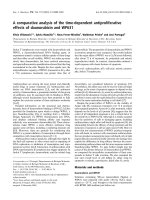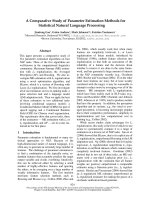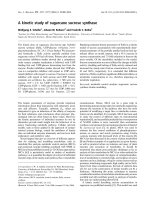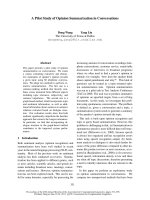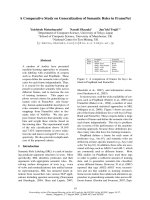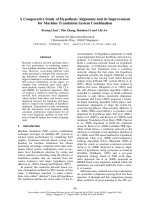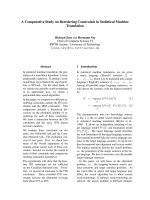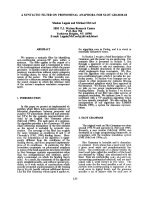Báo cáo khoa học: "A Comparative Study on Generalization of Semantic Roles in FrameNet" ppt
Bạn đang xem bản rút gọn của tài liệu. Xem và tải ngay bản đầy đủ của tài liệu tại đây (437.82 KB, 9 trang )
Proceedings of the 47th Annual Meeting of the ACL and the 4th IJCNLP of the AFNLP, pages 19–27,
Suntec, Singapore, 2-7 August 2009.
c
2009 ACL and AFNLP
A Comparative Study on Generalization of Semantic Roles in FrameNet
Yuichiroh Matsubayashi
†
Naoaki Okazaki
†
Jun’ichi Tsujii
†‡∗
†
Department of Computer Science, University of Tokyo, Japan
‡
School of Computer Science, University of Manchester, UK
∗
National Centre for Text Mining, UK
{y-matsu,okazaki,tsujii}@is.s.u-tokyo.ac.jp
Abstract
A number of studies have presented
machine-learning approaches to semantic
role labeling with availability of corpora
such as FrameNet and PropBank. These
corpora define the semantic roles of predi-
cates for each frame independently. Thus,
it is crucial for the machine-learning ap-
proach to generalize semantic roles across
different frames, and to increase the size
of training instances. This paper ex-
plores several criteria for generalizing se-
mantic roles in FrameNet: role hierar-
chy, human-understandable descriptors of
roles, semantic types of filler phrases, and
mappings from FrameNet roles to the-
matic roles of VerbNet. We also pro-
pose feature functions that naturally com-
bine and weight these criteria, based on
the training data. The experimental result
of the role classification shows 19.16%
and 7.42% improvements in error reduc-
tion rate and macro-averaged F1 score, re-
spectively. We also provide in-depth anal-
yses of the proposed criteria.
1 Introduction
Semantic Role Labeling (SRL) is a task of analyz-
ing predicate-argument structures in texts. More
specifically, SRL identifies predicates and their
arguments with appropriate semantic roles. Re-
solving surface divergence of texts (e.g., voice
of verbs and nominalizations) into unified seman-
tic representations, SRL has attracted much at-
tention from researchers into various NLP appli-
cations including question answering (Narayanan
and Harabagiu, 2004; Shen and Lapata, 2007;
buy.v PropBank FrameNet
Frame buy.01 Commerce buy
Roles ARG0: buyer Buyer
ARG1: thing bought Goods
ARG2: seller Seller
ARG3: paid Money
ARG4: benefactive Recipient
Figure 1: A comparison of frames for buy.v de-
fined in PropBank and FrameNet
Moschitti et al., 2007), and information extrac-
tion (Surdeanu et al., 2003).
In recent years, with thewide availability of cor-
pora such as PropBank (Palmer et al., 2005) and
FrameNet (Baker et al., 1998), a number of stud-
ies have presented statistical approaches to SRL
(M
`
arquez et al., 2008). Figure 1 shows an exam-
ple of the frame definitions for a verb buy in Prop-
Bank and FrameNet. These corpora define a large
number of frames and define the semantic roles for
each frame independently. This fact is problem-
atic in terms of the performance of the machine-
learning approach, because these definitions pro-
duce many roles that have few training instances.
PropBank defines a frame for each sense of
predicates (e.g., buy.01), and semantic roles are
defined in a frame-specific manner (e.g., buyer and
seller for buy.01). In addition, these roles are asso-
ciated with tags such as ARG0-5 and AM-*, which
are commonly used in different frames. Most
SRL studies on PropBank have used these tags
in order to gather a sufficient amount of training
data, and to generalize semantic-role classifiers
across different frames. However, Yi et al. (2007)
reported that tags ARG2–ARG5 were inconsis-
tent and not that suitable as training instances.
Some recent studies have addressed alternative ap-
proaches to generalizing semantic roles across dif-
ferent frames (Gordon and Swanson, 2007; Zapi-
19
Transfer::Recipient
Giving::Recipient
Commerce_buy::Buyer
Commerce_sell :: Buyer
Commerce_buy::SellerCommerce_sell::Seller
Giving::Donor
Transfer::Donor
Buyer Seller
Agent
role-to-role relation
hierarchical class
thematic role
role descriptor
Recipient
Donor
Figure 2: An example of role groupings using different criteria.
rain et al., 2008).
FrameNet designs semantic roles as frame spe-
cific, but also defines hierarchical relations of se-
mantic roles among frames. Figure 2 illustrates
an excerpt of the role hierarchy in FrameNet; this
figure indicates that the Buyer role for the Com-
merce buy frame (Commerce buy::Buyer here-
after) and the Commerce sell::Buyer role are in-
herited from the Transfer::Recipient role. Al-
though the role hierarchy was expected to gener-
alize semantic roles, no positive results for role
classification have been reported (Baldewein et al.,
2004). Therefore, the generalization of semantic
roles across different frames has been brought up
as a critical issue for FrameNet (Gildea and Juraf-
sky, 2002; Shi and Mihalcea, 2005; Giuglea and
Moschitti, 2006)
In this paper, we explore several criteria for gen-
eralizing semantic roles in FrameNet. In addi-
tion to the FrameNet hierarchy, we use various
pieces of information: human-understandable de-
scriptors of roles, semantic types of filler phrases,
and mappings from FrameNet roles to the thematic
roles of VerbNet. We also propose feature func-
tions that naturally combines these criteria in a
machine-learning framework. Using the proposed
method, the experimental result of the role classi-
fication shows 19.16% and 7.42% improvements
in error reduction rate and macro-averaged F1, re-
spectively. We provide in-depth analyses with re-
spect to these criteria, and state our conclusions.
2 Related Work
Moschitti et al. (2005) first classified roles by us-
ing four coarse-grained classes (Core Roles, Ad-
juncts, Continuation Arguments and Co-referring
Arguments), and built a classifier for each coarse-
grained class to tag PropBank ARG tags. Even
though the initial classifiers could perform rough
estimations of semantic roles, this step was not
able to solve the ambiguity problem in PropBank
ARG2-5. When training a classifier for a seman-
tic role, Baldewein et al. (2004) re-used the train-
ing instances of other roles that were similar to the
target role. As similarity measures, they used the
FrameNet hierarchy, peripheral roles of FrameNet,
and clusters constructed by a EM-based method.
Gordon and Swanson (2007) proposed a general-
ization method for the PropBank roles based on
syntactic similarity in frames.
Many previous studies assumed that thematic
roles bridged semantic roles in different frames.
Gildea and Jurafsky (2002) showed that classifica-
tion accuracy was improved by manually replac-
ing FrameNet roles into 18 thematic roles. Shi
and Mihalcea (2005) and Giuglea and Moschitti
(2006) employed VerbNet thematic roles as the
target of mappings from the roles defined by the
different semantic corpora. Using the thematic
roles as alternatives of ARG tags, Loper et al.
(2007) and Yi et al. (2007) demonstrated that the
classification accuracy of PropBank roles was im-
proved for ARG2 roles, but that it was diminished
for ARG1. Yi et al. (2007) also described that
ARG2–5 were mapped to a variety of thematic
roles. Zapirain et al. (2008) evaluated PropBank
ARG tags and VerbNetthematic roles in a state-of-
the-art SRL system, and concluded that PropBank
ARG tags achieved a more robust generalization of
the roles than did VerbNet thematic roles.
3 Role Classification
SRL is a complex task wherein several problems
are intertwined: frame-evoking word identifica-
tion, frame disambiguation (selecting a correct
frame from candidates for the evoking word), role-
phrase identification (identifying phrases that fill
semantic roles), and role classification (assigning
correct roles to the phrases). In this paper, we fo-
cus on role classification, in which the role gen-
eralization is particularly critical to the machine
learning approach.
In the role classification task, we are given a
sentence, a frame evoking word, a frame, and
20
Role-descriptor groupsHierarchical-relation groups
Semantic-type groups
Thematic-role groups
Figure 4: Examples for each type of role group.
INPUT:
frame = Commerce_sell
candidate roles ={Seller, Buyer, Goods, Reason, Time, , Place}
sentence = Can't [you] [sell
Commerce_sell
] [the factory] [to some other
company] ?
OUTPUT:
sentence = Can't [you
Seller
] [sell
Commerce_sell
] [the factory
Goods
]
[to some other company
Buyer
] ?
Figure 3: An example of input and output of role
classification.
phrases that take semantic roles. We are inter-
ested in choosing the correct role from the can-
didate roles for each phrase in the frame. Figure 3
shows a concrete example of input and output; the
semantic roles for the phrases are chosen from the
candidate roles: Seller, Buyer, Goods, Reason,
, and Place.
4 Design of Role Groups
We formalize the generalization of semantic roles
as the act of grouping several roles into a
class. We define a role group as a set of
role labels grouped by a criterion. Figure 4
shows examples of role groups; a group Giv-
ing::Donor (in the hierarchical-relation groups)
contains the roles Giving::Donor and Com-
merce pay::Buyer. The remainder of this section
describes the grouping criteria in detail.
4.1 Hierarchical relations among roles
FrameNet defines hierarchical relations among
frames (frame-to-frame relations). Each relation
is assigned one of the seven types of directional
relationships (Inheritance, Using, Perspective on,
Causative of, Inchoative of, Subframe, and Pre-
cedes). Some roles in two related frames are also
connected with role-to-role relations. We assume
that this hierarchy is a promising resource for gen-
eralizing the semantic roles; the idea is that the
role at a node in the hierarchy inherits the char-
acteristics of the roles of its ancestor nodes. For
example, Commerce sell::Seller in Figure 2 in-
herits the property of Giving::Donor.
For Inheritance, Using, Perspective on, and
Subframe relations, we assume that descendant
roles in these relations have the same or special-
ized properties of their ancestors. Hence, for each
role y
i
, we define the following two role groups,
H
child
y
i
= {y|y = y
i
∨ y is a child of y
i
},
H
desc
y
i
= {y|y = y
i
∨ y is a descendant of y
i
}.
The hierarchical-relation groups in Figure 4 are
the illustrations of H
desc
y
i
.
For the relation types Inchoative of and
Causative of, we define role groups in the oppo-
site direction of the hierarchy,
H
parent
y
i
= {y|y = y
i
∨ y is a parent of y
i
},
H
ance
y
i
= {y|y = y
i
∨ y is an ancestor of y
i
}.
This is because lower roles of Inchoative of
and Causative of relations represent more neu-
tral stances or consequential states; for example,
Killing::Victim is a parent of Death::Protagonist
in the Causative of relation.
Finally, the Precedes relation describes the se-
quence of states and events, but does not spec-
ify the direction of semantic inclusion relations.
Therefore, we simply try H
child
y
i
, H
desc
y
i
, H
parent
y
i
,
and H
ance
y
i
for this relation type.
4.2 Human-understandable role descriptor
FrameNet defines each role as frame-specific; in
other words, the same identifier does not appear
in different frames. However, in FrameNet,
human experts assign a human-understandable
name to each role in a rather systematic man-
ner. Some names are shared by the roles in
different frames, whose identifiers are dif-
ferent. Therefore, we examine the semantic
21
commonality of these names; we construct an
equivalence class of the roles sharing the same
name. We call these human-understandable
names role descriptors. In Figure 4, the role-
descriptor group Buyer collects the roles Com-
merce pay::Buyer, Commerce buy::Buyer,
and Commerce sell::Buyer.
This criterion may be effective in collecting
similar roles since the descriptors have been anno-
tated by intuition of human experts. As illustrated
in Figure 2, the role descriptors group the seman-
tic roles which are similar to the roles that the
FrameNet hierarchy connects as sister or parent-
child relations. However, role-descriptor groups
cannot express the relations between the roles
as inclusions since they are equivalence classes.
For example, the roles Commerce sell::Buyer
and Commerce buy::Buyer are included in the
role descriptor group Buyer in Figure 2; how-
ever, it is difficult to merge Giving::Recipient
and Commerce sell::Buyer because the Com-
merce sell::Buyer has the extra property that one
gives something of value in exchange and a hu-
man assigns different descriptors to them. We ex-
pect that the most effective weighting of these two
criteria will be determined from the training data.
4.3 Semantic type of phrases
We consider that the selectional restriction is help-
ful in detecting the semantic roles. FrameNet pro-
vides information concerning the semantic types
of role phrases (fillers); phrases that play spe-
cific roles in a sentence should fulfill the se-
mantic constraint from this information. For
instance, FrameNet specifies the constraint that
Self motion::Area should be filled by phrases
whose semantic type is Location. Since these
types suggest a coarse-grained categorization of
semantic roles, we construct role groups that con-
tain roles whose semantic types are identical.
4.4 Thematic roles of VerbNet
VerbNet thematic roles are 23 frame-independent
semantic categories for arguments of verbs,
such as Agent, Patient, Theme and Source.
These categories have been used as consis-
tent labels across verbs. We use a partial
mapping between FrameNet roles and Verb-
Net thematic roles provided by SemLink.
1
Each group is constructed as a set T
t
i
=
1
/>{y|SemLink maps y into the thematic role t
i
}.
SemLink currently maps 1,726 FrameNet roles
into VerbNet thematic roles, which are 37.61% of
roles appearing at least once in the FrameNet cor-
pus. This may diminish the effect of thematic-role
groups than its potential.
5 Role classification method
5.1 Traditional approach
We are given a frame-evoking word e, a frame f
and a role phrase x detected by a human or some
automatic process in a sentence s. Let Y
f
be the
set of semantic roles that FrameNet defines as be-
ing possible role assignments for the frame f, and
let x = {x
1
, . . . , x
n
} be observed features for x
from s, e and f. The task of semantic role classifi-
cation can be formalized as the problem of choos-
ing the most suitable role ˜y from Y
f
. Suppose we
have a model P(y|f, x) which yields the condi-
tional probability of the semantic role y for given
f and x. Then we can choose ˜y as follows:
˜y = argmax
y∈Y
f
P (y |f, x). (1)
A traditional way to incorporate role groups
into this formalization is to overwrite each role
y in the training and test data with its role
group m(y) according to the memberships of
the group. For example, semantic roles Com-
merce sell::Seller and Giving::Donor can be re-
placed by their thematic-role group Theme::Agent
in this approach. We determine the most suitable
role group ˜c as follows:
˜c = argmax
c∈{m(y)|y∈Y
f
}
P
m
(c|f, x). (2)
Here, P
m
(c|f, x) presents the probability of the
role group c for f and x. The role ˜y is determined
uniquely iff a single role y ∈ Y
f
is associated
with ˜c. Some previous studies have employed this
idea to remedy the data sparseness problem in the
training data (Gildea and Jurafsky, 2002). How-
ever, we cannot apply this approach when multi-
ple roles in Y
f
are contained in the same class. For
example, we can construct a semantic-type group
St::State of affairs in which Giving::Reason and
Giving::Means are included, as illustrated in Fig-
ure 4. If ˜c = St::State of affairs, we cannot dis-
ambiguate which original role is correct. In ad-
dition, it may be more effective to use various
22
groupings of roles together in the model. For in-
stance, the model could predict the correct role
Commerce sell::Seller for the phrase “you” in
Figure 3 more confidently, if it could infer its
thematic-role group as Theme::Agent and its par-
ent group Giving::Donor correctly. Although the
ensemble of various groupings seems promising,
we need an additional procedure to prioritize the
groupings for the case where the models for mul-
tiple role groupings disagree; for example, it is un-
satisfactory if two models assign the groups Giv-
ing::Theme and Theme::Agent to the same phrase.
5.2 Role groups as feature functions
We thus propose another approach that incorpo-
rates group information as feature functions. We
model the conditional probability P (y|f, x) by us-
ing the maximum entropy framework,
p(y|f, x) =
exp(
∑
i
λ
i
g
i
(x, y))
∑
y∈Y
f
exp(
∑
i
λ
i
g
i
(x, y))
. (3)
Here, G = {g
i
} denotes a set of n feature func-
tions, and Λ = {λ
i
} denotes a weight vector for
the feature functions.
In general, feature functions for the maximum
entropy model are designed as indicator functions
for possible pairs of x
j
and y. For example, the
event where the head word of x is “you” (x
1
= 1)
and x plays the role Commerce sell::Seller in a
sentence is expressed by the indicator function,
g
role
1
(x, y) =
1 (x
1
= 1 ∧
y = Commerce sell::Seller)
0 (otherwise)
.
(4)
We call this kind of feature function an x-role.
In order to incorporate role groups into the
model, we also include all feature functions for
possible pairs of x
j
and role groups. Equation 5
is an example of a feature function for instances
where the head word of x is “you” and y is in the
role group Theme::Agent,
g
theme
2
(x, y) =
1 (x
1
= 1 ∧
y ∈ Theme::Agent)
0 (otherwise)
. (5)
Thus, this feature function fires for the roles wher-
ever the head word “you” plays Agent (e.g., Com-
merce sell::Seller, Commerce buy::Buyer and
Giving::Donor). We call this kind of feature func-
tion an x-group function.
In this way, we obtain x-group functions for
all grouping methods, e.g., g
theme
k
, g
hierarchy
k
.
The role-group features will receive more training
instances by collecting instances for fine-grained
roles. Thus, semantic roles with few training in-
stances are expected to receive additional clues
from other training instances via role-group fea-
tures. Another advantage of this approach is that
the usefulness of the different role groups is de-
termined by the training processes in terms of
weights of feature functions. Thus, we do not need
to assume that we have found the best criterion for
grouping roles; we can allow a training process to
choose the criterion. We will discuss the contribu-
tions of different groupings in the experiments.
5.3 Comparison with related work
Baldewein et al. (2004) suggested an approach
that uses role descriptors and hierarchical rela-
tions as criteria for generalizing semantic roles
in FrameNet. They created a classifier for each
frame, additionally using training instances for the
role A to train the classifier for the role B, if the
roles A and B were judged as similar by a crite-
rion. This approach performs similarly to the over-
writing approach, and it may obscure the differ-
ences among roles. Therefore, they only re-used
the descriptors as a similarity measure for the roles
whose coreness was peripheral.
2
In contrast, we use all kinds of role descriptors
to construct groups. Since we use the feature func-
tions for both the original roles and their groups,
appropriate units for classification are determined
automatically in the training process.
6 Experiment and Discussion
We used the training set of the Semeval-2007
Shared task (Baker et al., 2007) in order to ascer-
tain the contributions of role groups. This dataset
consists of the corpus of FrameNet release 1.3
(containing roughly 150,000 annotations), and an
additional full-text annotation dataset. We ran-
domly extracted 10% of the dataset for testing, and
used the remainder (90%) for training.
Performance was measured by micro- and
macro-averaged F1 (Chang and Zheng, 2008) with
respect to a variety of roles. The micro average bi-
ases each F1 score by the frequencies of the roles,
2
In FrameNet, each role is assigned one of four different
types of coreness (core, core-unexpressed, peripheral, extra-
thematic) It represents the conceptual necessity of the roles
in the frame to which it belongs.
23
and the average is equal to the classification accu-
racy when we calculate it with all of the roles in
the test set. In contrast, the macro average does
not bias the scores, thus the roles having a small
number of instances affect the average more than
the micro average.
6.1 Experimental settings
We constructed a baseline classifier that uses
only the x-role features. The feature de-
sign is similar to that of the previous stud-
ies (M
`
arquez et al., 2008). The characteristics
of x are: frame, frame evoking word, head
word, content word (Surdeanu et al., 2003),
first/last word, head word of left/right sister,
phrase type, position, voice, syntactic path (di-
rected/undirected/partial), governing category
(Gildea and Jurafsky, 2002), WordNet super-
sense in the phrase, combination features of
frame evoking word & headword, combination
features of frame evoking word & phrase type,
and combination features of voice & phrase type.
We also used PoS tags and stem forms as extra
features of any word-features.
We employed Charniak and Johnson’s rerank-
ing parser (Charniak and Johnson, 2005) to an-
alyze syntactic trees. As an alternative for the
traditional named-entity features, we used Word-
Net supersenses: 41 coarse-grained semantic cate-
gories of words such as person, plant, state, event,
time, location. We used Ciaramita and Altun’s Su-
per Sense Tagger (Ciaramita and Altun, 2006) to
tag the supersenses. The baseline system achieved
89.00% with respect to the micro-averaged F1.
The x-group features were instantiated similarly
to the x-role features; the x-group features com-
bined the characteristics of x with the role groups
presented in this paper. The total number of fea-
tures generated for all x-roles and x-groups was
74,873,602. The optimal weights Λ of the fea-
tures were obtained by the maximum a poste-
rior (MAP) estimation. We maximized an L
2
-
regularized log-likelihood of the training set us-
ing the Limited-memory BFGS (L-BFGS) method
(Nocedal, 1980).
6.2 Effect of role groups
Table 1 shows the micro and macro averages of F1
scores. Each role group type improved the micro
average by 0.5 to 1.7 points. The best result was
obtained by using all types of groups together. The
result indicates that different kinds of group com-
Feature Micro Macro −Err.
Baseline 89.00 68.50 0.00
role descriptor 90.78 76.58 16.17
role descriptor (replace) 90.23 76.19 11.23
hierarchical relation 90.25 72.41 11.40
semantic type 90.36 74.51 12.38
VN thematic role 89.50 69.21 4.52
All 91.10 75.92 19.16
Table 1: The accuracy and error reduction rate of
role classification for each type of role group.
Feature #instances Pre. Rec. Micro
baseline ≤ 10 63.89 38.00 47.66
≤ 20 69.01 51.26 58.83
≤ 50 75.84 65.85 70.50
+ all groups ≤ 10 72.57 55.85 63.12
≤ 20 76.30 65.41 70.43
≤ 50 80.86 74.59 77.60
Table 2: The effect of role groups on the roles with
few instances.
plement each other with respect to semantic role
generalization. Baldewein et al. (2004) reported
that hierarchical relations did not perform well for
their method and experimental setting; however,
we found that significant improvements could also
be achieved with hierarchical relations. We also
tried a traditional label-replacing approach with
role descriptors (in the third row of Table 1). The
comparison between the second and third rows in-
dicates that mixing the original fine-grained roles
and the role groups does result in a more accurate
classification.
By using all types of groups together, the
model reduced 19.16 % of the classification errors
from the baseline. Moreover, the macro-averaged
F1 scores clearly showed improvements resulting
from using role groups. In order to determine
the reason for the improvements, we measured
the precision, recall, and F1-scores with respect
to roles for which the number of training instances
was at most 10, 20, and 50. In Table 2, we show
that the micro-averaged F1 score for roles hav-
ing 10 instances or less was improved (by 15.46
points) when all role groups were used. This result
suggests the reason for the effect of role groups; by
bridging similar semantic roles, they supply roles
having a small number of instances with the infor-
mation from other roles.
6.3 Analyses of role descriptors
In Table 1, the largest improvement was obtained
by the use of role descriptors. We analyze the ef-
fect of role descriptors in detail in Tables 3 and 4.
Table 3 shows the micro-averaged F1 scores of all
24
Coreness #roles #instances/#role #groups #instances/#group #roles/#group
Core 1902 122.06 655 354.4 2.9
Peripheral 1924 25.24 250 194.3 7.7
Extra-thematic 763 13.90 171 62.02 4.5
Table 4: The analysis of the numbers of roles, instances, and role-descriptor groups, for each type of
coreness.
Coreness Micro
Baseline 89.00
Core 89.51
Peripheral 90.12
Extra-thematic 89.09
All 90.77
Table 3: The effect of employing role-descriptor
groups of each type of coreness.
semantic roles when we use role-descriptor groups
constructed from each type of coreness (core
3
, pe-
ripheral, and extra-thematic) individually. The pe-
ripheral type generated the largest improvements.
Table 4 shows the number of roles associated
with each type of coreness (#roles), the number of
instances for the original roles (#instances/#role),
the number of groups for each type of coreness
(#groups), the number of instances for each group
(#instances/#group), and the number of roles per
each group (#roles/#group). In the peripheral
type, the role descriptors subdivided 1,924 distinct
roles into 250 groups, each of which contained 7.7
roles on average. The peripheral type included
semantic roles such as place, time, reason, dura-
tion. These semantic roles appear in many frames,
because they have general meanings that can be
shared by different frames. Moreover, the seman-
tic roles of peripheral type originally occurred in
only a small number (25.24) of training instances
on average. Thus, we infer that the peripheral
type generated the largest improvement because
semantic roles in this type acquired the greatest
benefit from the generalization.
6.4 Hierarchical relations and relation types
We analyzed the contributions of the FrameNet hi-
erarchy for each type of role-to-role relations and
for different depths of grouping. Table 5 shows
the micro-averaged F1 scores obtained from var-
ious relation types and depths. The Inheritance
and Using relations resulted in a slightly better ac-
curacy than the other types. We did not observe
any real differences among the remaining five re-
lation types, possibly because there were few se-
3
We include Core-unexpressed in core, because it has a
property of core inside one frame.
No. Relation Type Micro
- baseline 89.00
1 + Inheritance (children) 89.52
2 + Inheritance (descendants) 89.70
3 + Using (children) 89.35
4 + Using (descendants) 89.37
5 + Perspective on (children) 89.01
6 + Perspective on (descendants) 89.01
7 + Subframe (children) 89.04
8 + Subframe (descendants) 89.05
9 + Causative of (parents) 89.03
10 + Causative of (ancestors) 89.03
11 + Inchoative of (parents) 89.02
12 + Inchoative of (ancestors) 89.02
13 + Precedes (children) 89.01
14 + Precedes (descendants) 89.03
15 + Precedes (parents) 89.00
16 + Precedes (ancestors) 89.00
18 + all relations (2,4,6,8,10,12,14) 90.25
Table 5: Comparison of the accuracy with differ-
ent types of hierarchical relations.
mantic roles associated with these types. We ob-
tained better results by using not only groups for
parent roles, but also groups for all ancestors. The
best result was obtained by using all relations in
the hierarchy.
6.5 Analyses of different grouping criteria
Table 6 reports the precision, recall, and micro-
averaged F1 scores of semantic roles with respect
to each coreness type.
4
In general, semantic roles
of the core coreness were easily identified by all
of the grouping criteria; even the baseline system
obtained an F1 score of 91.93. For identifying se-
mantic roles of the peripheral and extra-thematic
types of coreness, the simplest solution, the de-
scriptor criterion, outperformed other criteria.
In Table 7, we categorize feature functions
whose weights are in the top 1000 in terms of
greatest absolute value. The behaviors of the role
groups can be distinguished by the following two
characteristics. Groups of role descriptors and se-
mantic types have large weight values for the first
word and supersense features, which capture the
characteristics of adjunctive phrases. The original
roles and hierarchical-relation groups have strong
4
The figures of role descriptors in Tables 4 and 6 differ.
In Table 4, we measured the performance when we used one
or all types of coreness for training. In contrast, in Table 6,
we used all types of coreness for training, but computed the
performance of semantic roles for each coreness separately.
25
Feature Type Pre. Rec. Micro
baseline c 91.07 92.83 91.93
p 81.05 76.03 78.46
e 78.17 66.51 71.87
+ descriptor group c 92.50 93.41 92.95
p 84.32 82.72 83.51
e 80.91 69.59 74.82
+ hierarchical c 92.10 93.28 92.68
relation p 82.23 79.84 81.01
class e 77.94 65.58 71.23
+ semantic c 92.23 93.31 92.77
type group p 83.66 81.76 82.70
e 80.29 67.26 73.20
+ VN thematic c 91.57 93.06 92.31
role group p 80.66 76.95 78.76
e 78.12 66.60 71.90
+ all group c 92.66 93.61 93.13
p 84.13 82.51 83.31
e 80.77 68.56 74.17
Table 6: The precision and recall of each type of
coreness with role groups. Type represents the
type of coreness; c denotes core, p denotes periph-
eral, and e denotes extra-thematic.
associations with lexical and structural character-
istics such as the syntactic path, content word, and
head word. Table 7 suggests that role-descriptor
groups and semantic-type groups are effective for
peripheral or adjunctive roles, and hierarchical re-
lation groups are effective for core roles.
7 Conclusion
We have described different criteria for general-
izing semantic roles in FrameNet. They were:
role hierarchy, human-understandable descriptors
of roles, semantic types of filler phrases, and
mappings from FrameNet roles to thematic roles
of VerbNet. We also proposed a feature design
that combines and weights these criteria using the
training data. The experimental result of the role
classification task showed a 19.16% of the error
reduction and a 7.42% improvement in the macro-
averaged F1 score. In particular, the method we
have presented was able to classify roles having
few instances. We confirmed that modeling the
role generalization at feature level was better than
the conventional approach that replaces semantic
role labels.
Each criterion presented in this paper improved
the accuracy of classification. The most success-
ful criterion was the use of human-understandable
role descriptors. Unfortunately, the FrameNet hi-
erarchy did not outperform the role descriptors,
contrary to our expectations. A future direction
of this study would be to analyze the weakness of
the FrameNet hierarchy in order to discuss possi-
ble improvement of the usage and annotations of
features of x class type
or hr rl st vn
frame 0 4 0 1 0
evoking word 3 4 7 3 0
ew & hw stem 9 34 20 8 0
ew & phrase type 11 7 11 3 1
head word 13 19 8 3 1
hw stem 11 17 8 8 1
content word 7 19 12 3 0
cw stem 11 26 13 5 0
cw PoS 4 5 14 15 2
directed path 19 27 24 6 7
undirected path 21 35 17 2 6
partial path 15 18 16 13 5
last word 15 18 12 3 2
first word 11 23 53 26 10
supersense 7 7 35 25 4
position 4 6 30 9 5
others 27 29 33 19 6
total 188 298 313 152 50
Table 7: The analysis of the top 1000 feature func-
tions. Each number denotes the number of feature
functions categorized in the corresponding cell.
Notations for the columns are as follows. ‘or’:
original role, ‘hr’: hierarchical relation, ‘rd’: role
descriptor, ‘st’: semantic type, and ‘vn’: VerbNet
thematic role.
the hierarchy.
Since we used the latest release of FrameNet
in order to use a greater number of hierarchical
role-to-role relations, we could not make a direct
comparison of performance with that of existing
systems; however we may say that the 89.00% F1
micro-average of our baseline system is roughly
comparable to the 88.93% value of Bejan and
Hathaway (2007) for SemEval-2007 (Baker et al.,
2007).
5
In addition, the methodology presented in
this paper applies generally to any SRL resources;
we are planning to determine several grouping cri-
teria from existing linguistic resources and to ap-
ply the methodology to the PropBank corpus.
Acknowledgments
The authors thank Sebastian Riedel for his useful
comments on our work. This work was partially
supported by Grant-in-Aid for Specially Promoted
Research (MEXT, Japan).
References
Collin F. Baker, Charles J. Fillmore, and John B. Lowe.
1998. The berkeley framenet project. In Proceed-
ings of Coling-ACL 1998, pages 86–90.
Collin Baker, Michael Ellsworth, and Katrin Erk.
2007. Semeval-2007 task 19: Frame semantic struc-
5
There were two participants that performed whole SRL
in SemEval-2007. Bejan and Hathaway (2007) evaluated role
classification accuracy separately for the training data.
26
ture extraction. In Proceedings of SemEval-2007,
pages 99–104.
Ulrike Baldewein, Katrin Erk, Sebastian Pad
´
o, and
Detlef Prescher. 2004. Semantic role labeling
with similarity based generalization using EM-based
clustering. In Proceedings of Senseval-3, pages 64–
68.
Cosmin Adrian Bejan and Chris Hathaway. 2007.
UTD-SRL: A Pipeline Architecture for Extract-
ing Frame Semantic Structures. In Proceedings
of SemEval-2007, pages 460–463. Association for
Computational Linguistics.
X. Chang and Q. Zheng. 2008. Knowledge Ele-
ment Extraction for Knowledge-Based Learning Re-
sources Organization. Lecture Notes in Computer
Science
, 4823:102–113.
Eugene Charniak and Mark Johnson. 2005. Coarse-
to-fine n-best parsing and MaxEnt discriminative
reranking. In Proceedings of the 43rd Annual Meet-
ing on Association for Computational Linguistics,
pages 173–180.
Massimiliano Ciaramita and Yasemin Altun. 2006.
Broad-coverage sense disambiguation and informa-
tion extraction with a supersense sequence tagger. In
Proceedings of EMNLP-2006, pages 594–602.
Daniel Gildea and Daniel Jurafsky. 2002. Automatic
labeling of semantic roles. Computational Linguis-
tics, 28(3):245–288.
Ana-Maria Giuglea and Alessandro Moschitti. 2006.
Semantic role labeling via FrameNet, VerbNet and
PropBank. In Proceedings of the 21st International
Conference on Computational Linguistics and the
44th Annual Meeting of the ACL, pages 929–936.
Andrew Gordon and Reid Swanson. 2007. General-
izing semantic role annotations across syntactically
similar verbs. In Proceedings of ACL-2007, pages
192–199.
Edward Loper, Szu-ting Yi, and Martha Palmer. 2007.
Combining lexical resources: Mapping between
propbank and verbnet. In Proceedings of the 7th In-
ternational Workshop on Computational Semantics,
pages 118–128.
Llu
´
ıs M
`
arquez, Xavier Carreras, Kenneth C.
Litkowski, and Suzanne Stevenson. 2008. Se-
mantic role labeling: an introduction to the special
issue. Computational linguistics, 34(2):145–159.
Alessandro Moschitti, Ana-Maria Giuglea, Bonaven-
tura Coppola, and Roberto Basili. 2005. Hierar-
chical semantic role labeling. In Proceedings of
CoNLL-2005, pages 201–204.
Alessandro Moschitti, Silvia Quarteroni, Roberto
Basili, and Suresh Manandhar. 2007. Exploiting
syntactic and shallow semantic kernels for question
answer classification. In Proceedings of ACL-07,
pages 776–783.
Srini Narayanan and Sanda Harabagiu. 2004. Ques-
tion answering based on semantic structures. In Pro-
ceedings of Coling-2004, pages 693–701.
Jorge Nocedal. 1980. Updating quasi-newton matrices
with limited storage. Mathematics of Computation,
35(151):773–782.
Martha Palmer, Daniel Gildea, and Paul Kingsbury.
2005. The proposition bank: An annotated cor-
pus of semantic roles. Computational Linguistics,
31(1):71–106.
Dan Shen and Mirella Lapata. 2007. Using semantic
roles to improve question answering. In Proceed-
ings of EMNLP-CoNLL 2007, pages 12–21.
Lei Shi and Rada Mihalcea. 2005. Putting Pieces To-
gether: Combining FrameNet, VerbNet and Word-
Net for Robust Semantic Parsing. In Proceedings of
CICLing-2005, pages 100–111.
Mihai Surdeanu, Sanda Harabagiu, John Williams, and
Paul Aarseth. 2003. Using predicate-argument
structures for information extraction. In Proceed-
ings of ACL-2003, pages 8–15.
Szu-ting Yi, Edward Loper, and Martha Palmer. 2007.
Can semantic roles generalize across genres? In
Proceedings of HLT-NAACL 2007, pages 548–555.
Be
˜
nat Zapirain, Eneko Agirre, and Llu
´
ıs M
`
arquez.
2008. Robustness and generalization of role sets:
PropBank vs. VerbNet. In Proceedings of ACL-08:
HLT, pages 550–558.
27
